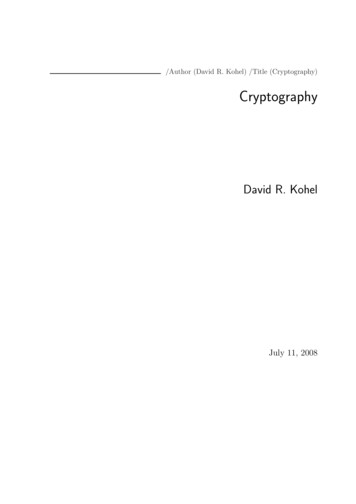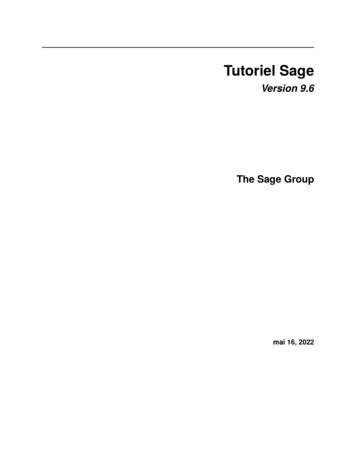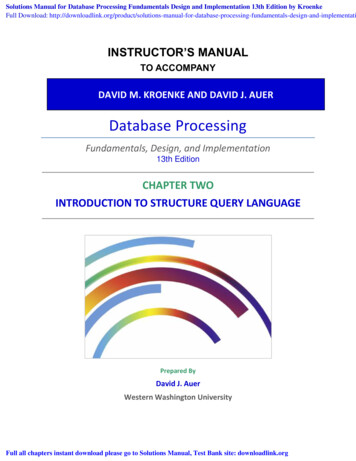
Transcription
/Author (David R. Kohel) /Title (Cryptography)CryptographyDavid R. KohelJuly 11, 2008
This work is licensed under aCreative Commons Attribution-Noncommercial-Share Alike 3.0 Unported License.See http://creativecommons.org for details.c David R. Kohel
ii
CONTENTS1 Introduction to Cryptography1.1 Definitions and Terminology . . . . . . . . . . . . . . . . . . . . . . . . . .1.2 String Monoids . . . . . . . . . . . . . . . . . . . . . . . . . . . . . . . . .1.3 Cryptosystems . . . . . . . . . . . . . . . . . . . . . . . . . . . . . . . . .33472 Classical Cryptography2.1 Substitution Ciphers . . . . . . . . . . . . . . . . . . . . . . . . . . . . . .2.2 Transposition Ciphers . . . . . . . . . . . . . . . . . . . . . . . . . . . . .99133 Elementary Cryptanalysis3.1 Classification of Cryptanalytic Attacks3.2 Cryptanalysis by Frequency Analysis .3.3 Breaking the Vigenère Cipher . . . . .3.4 Cryptanalysis of Transposition Ciphers3.5 Statistical Measures . . . . . . . . . .191920242626.313133333434.3737404041. . . . . . . . . . . . . . . . . . . . . . . . . . .49494 Information Theory4.1 Entropy . . . . . . . . . . . . . . .4.2 Rate and Redundancy . . . . . . .4.3 Conditional Probability . . . . . .4.4 Conditional Entropy . . . . . . . .4.5 Perfect secrecy and one-time pads.5 Block Ciphers5.1 Product ciphers and Feistel ciphers . . . .5.2 Digital Encryption Standard Overview . .5.3 Advanced Encryption Standard Overview5.4 Modes of Operation . . . . . . . . . . . .6 Stream Ciphers6.1 Types of Stream Ciphers.iii
6.26.36.4Properties of Stream Ciphers . . . . . . . . . . . . . . . . . . . . . . . . .Linear Feedback Shift Registers . . . . . . . . . . . . . . . . . . . . . . . .Linear Complexity . . . . . . . . . . . . . . . . . . . . . . . . . . . . . . .5050547 Elementary Number Theory7.1 Quotient rings . . . . . . . . . . . . . . . . . . . . . . . . . . . . . . . . .7.2 The mod operator . . . . . . . . . . . . . . . . . . . . . . . . . . . . . . .7.3 Primes and Irreducibles . . . . . . . . . . . . . . . . . . . . . . . . . . . .595960618 Public Key Cryptography8.1 Public and Private Key Protocols8.2 RSA Cryptosystems . . . . . . .8.3 ElGamal Cryptosystems . . . . .8.4 Diffie–Hellman Key Exchange . .6767707274.79797980809 Digital Signatures9.1 RSA Signature Scheme . . . . .9.2 ElGamal Signature Scheme . . .9.3 Chaum’s Blind Signature Scheme9.4 Digital Cash Schemes . . . . . .10 Secret Sharing83A SAGE Constructions87B SAGE Cryptosystems97C Solutions to Exercises103D Revision Exercises133iv
PrefaceWhen embarking on a project to write a book in a subject saturated with such books,the natural question to ask is: what niche does this book fill not satisfied by other bookson the subject? The subject of cryptography attracts participants from many academicdisciplines, from mathematics to computer science and engineering. The goal of this bookis to provide an introduction which emphasizes the mathematical and algorithmic components and building blocks suitable for mathematics students, while liberally illustrating thetheory with examples. Most textbooks for a mathematics audience limit themselves to penand paper calculations, which fails to give the student a sense of either the asymptotic complexity for the algorithms or access to a practical range for cryptographic study. Textbookswhich take a computational view usually miss the conceptual framework of the mathematics, and are either tied to a particular commercial software package or emphasize low-levelcomputations in C or Java which requires a stronger computer science background. Wechoose to use the computer algebra system SAGE for experimental exploration, since thispackage is both freely available and designed for intuitive interactive use. We hope thatthis book will fill a niche by emphasizing a mathematical presentation of structures incryptography, without sacrificing the explicit exploration of the field.1
2
CHAPTERONEIntroduction to CryptographyCryptography is the study of mathematical techniques for all aspects of information security. Cryptanalysis is the complementary science concerned with the methods to defeatthese techniques. Cryptology is the study of cryptography and cryptanaylsis. Key features of information security information include confidentiality or privacy, data integrity,authentication, and nonrepudiation.Each of these aspects of message security can addressed by standard methods in cryptography. Besides exchange of messages, tools from cryptography can be applied to sharingan access key between multiple parties so that no one person can gain access to a vault byany two of them can. Another role is in the design of electronic forms of cash.1.1 Definitions and TerminologyEncryption the process of disguising a message so as to hide the information it contains;this process can include both encoding and enciphering (see definitions below).Protocol an algorithm, defined by a sequence of steps, precisely specifying the actions ofmultiple parties in order to achieve an objective.Plaintext the message to be transmitted or stored.Ciphertext the disguised message.Alphabet a collection of symbols, also referred to as characters.Character an element of an alphabet.Bit a character 0 or 1 of the binary alphabet.String a finite sequence of characters in some alphabet.Encode to convert a message into a representation in a standard alphabet, such as tothe alphabet {A, . . . , Z} or to numerical alphabet.3
Decode to convert the encoded message back to its original alphabet and original form— the term plaintext will apply to either the original or the encoded form. The process ofencoding a message is not an obscure process, and the result that we get can be consideredequivalent to the plaintext message.Cipher a map from a space of plaintext to a space of ciphertext.Encipher to convert plaintext into ciphertext.Decipher to convert ciphertext back to plaintext.Stream cipher a cipher which acts on the plaintext one symbol at a time.Block cipher a cipher which acts on the plaintext in blocks of symbols.Substitution cipher a stream cipher which acts on the plaintext by making a substitutionof the characters with elements of a new alphabet or by a permutation of the charactersin the plaintext alphabet.Transposition cipher a block cipher which acts on the plaintext by permuting the positions of the characters in the plaintext.Example. The following are some standard alphabets.A, . . . , mal26 symbols7-bit words (128 symbols)8-bit words (256 symbols)8-bit words (256 symbols){0,1}{0,. . . ,7}{0,. . . ,9}{0,. . . ,9,a,b,c,d,e,f}Classical alphabet (less punctuation)American standardWestern European standardNumerical alphabet base 2Numerical alphabet base 8Numerical alphabet base 10Numerical alphabet base 16Example. The following is an example of a substitution cipher:A B C D E F G H ··· Z ··· O N A W Y ··· L SP Cwhich takes the plaintext BAD CAFE BED to the ciphertext CPOS ANSNO.1.2 String MonoidsAn encoding or cipher is a transformation of data or text, whether expressed in the Roman alphabet, Chinese characters, or some binary, hexadecimal, or byte encoding of this4Cryptography
information. We introduce here some of the structures in which this text is stored, as thenatural domain and codomain on which encodings and ciphers operate. First we introducethe abstract notion of a monoid before specialising to the string monoids which form theobjects of interest.MonoidsA monoid is a set M together with a binary operation· : M M M,which is associative:(x · y) · z x · (y · z),and which contains a distinguished element e such that e · x x · e x. We note that amonoid in which every element x has an inverse element y in M, i.e. such that x · y eis called a group. If we both the axiom of existence of inverses and the axiom assertingexistence of an identity, we arrive at the notion of a semigroup.Monoid homomorphismsA monoid homomorphism is a map φ : M1 M2 such thatφ(x · y) φ(x) · φ(y),and which takes the identity in M1 to the identity in M2 . We denote the set of all monoidhomomorphism M1 M2 byHomMon (M1 , M2 ),or just Hom(M1 , M2 ) when it is clear that M1 and M2 are both monoids. In contrast,the set of all set-theoretic maps from M1 to M2 is denotedHomSet (M1 , M2 ).StringsGiven a finite alphabet A (a finite set of symbols), we write An for the n-fold productA · · · A, whose elements we call strings of length n, and let A [An ,n 0be the disjoint union over strings of all lengths. Then A forms a monoid under string concatentation, with identify the unique string in A0 , called the empty string. We identity Awith its image A1 in A , and write a string in An as x1 x2 · · · xn rather than (x1 , x2 , . . . , xn ).String Monoids5
The string monoids A form a very special class of monoids, called free monoids over A,which are characterized by the “universal” property:The set A generates A , and given any map A M to a monoid M, thereexists a unique monoid homomorphism A M which extends A M.Since the length of strings adds when composing (i.e. concatenating) them, clearly noelement other than the empty string in A has an inverse, thus it forms a monoid but nota group.We are interested in standard string monoids used in language and computers. Forexample, we let ASCII be the set of 256 binary strings of length 8, which represent text inthe computer. For instance, we have the following correspondence between characters inthe Roman alphabet, numeric decimal values and the binary representation of the ASCIIalphabet.Character Number ASCII .0110000101100010.z12201111010Note that the space character ” ” is a valid symbol in the ASCII alphabet, with numericvalue 32. In particular it is a symbol distinct from the identity element of the monoidASCII .We now let A be the alphabet consisting of the 26 symbols {A, B, . . . , Z}. There is anobvious monoid homomorphism ι : A ASCII induced by the inclusion A ASCII. Wecan define a map ASCII A by extending the mapA 7 AB 7 B.a 7 Ab 7 B.Z 7 Zz 7 Zto all of ASCII by sending all other characters to the empty string e. This induces amonoid homomorphism π : ASCII A such that the composition ι π is the identityhomomorphism on A , but π ι is far from injective on ASCII .This monoid homomorphism was commonly applied to plaintext in classical cryptosystems, to encode it prior to enciphering. As an example we see thatι π(The cat in the hat.) THECATINTHEHAT,6Cryptography
but strings in A map injectively into ASCII :π ι π(THECATINTHEHAT) π(THECATINTHEHAT) THECATINTHEHAT.The existence of the empty string is crucial to the definition of the map from ASCII toA , which shows that the concept of a monoid, rather than a semigroup, is the correct onefor study of strings and the transformations which operate on them (under the guise ofencodings or ciphers).In what follows the domain and codomain of ciphers will be string monoids or a subsetA of a string monoid A (for block ciphers). The latter ciphers may be extended naturally(in what is called ECB mode in Chapter 5) to the submonoid (An ) of A on the largeralphabet An . The concept of a string monoid gives a useful framework for understandingciphers. A first question to ask for a cipher whose domain is a string monoid is whetherthat cipher is a monoid homomorphism.n1.3 CryptosystemsThe notion of a cryptosystem or encryption scheme E captures the idea of a distinguishedset of ciphers indexed over some keyspace K:E {EK : M C : K K}.To every enciphering key K there exists a deciphering key K 0 with deciphering map DK 0 :C M. Now E should be thought of as a pair of algorithms E and D which take inputs(K, M ) and (K 0 , C), respectively.We formalise this definition as follows. First, we require a collection of sets:A plaintext alphabetM plaintext spaceK (plaintext) keyspaceA0 ciphertext alphabetC ciphertext spaceK0 (ciphertext) keyspacewhere M is a subset of A , C is a subset of A0 , and K and K0 are finite sets. A cryptosystemor encryption scheme is a pair (E, D) of mapsE : K M CD : K0 C Msuch that for each K in K there exists a K 0 in K0 such thatD(K 0 , E(K, M )) Mfor all M in M.1.3. Cryptosystems7
To recover to our original notion, for fixed K we write the cipherEK E(K, ·) : M C,and similarlyDK 0 D(K 0 , ·) : C M.With this notation the condition on E, D, K and K 0 is that DK 0 EK is the identity mapon M. In this way, we may express E and D as mapsE : K HomSet (M, C),D : K0 HomSet (C, M).We will refer to EK as a cipher, and note that a cipher is necessarily injective. For manycryptosystems, there will exist a unique deciphering key K 0 associated to each encipheringkey K. A cryptosystem for which the deciphering key K 0 equals K (hence K K0 ) orfor which K 0 can be easily obtained from K, is said to be symmetric. If the decipheringkey K 0 associated to K not easily computable from K, we say that the cryptosystem isasymmetric or a public key cryptosystem.A fundamental principle of (symmetric key) cryptography is Kerckhoff ’s principle, thatthe security of a cryptosystem does not rest on the lack of knowledge of the cryptosystemE (E, D). Instead, security should be based on the secrecy of the keys.Recall that a protocol is an algorithm, defined by a sequence of steps, precisely specifying the actions of multiple parties in order to achieve an objective. An example of acryptographic protocol, we describe the steps for message exchange using a symmetric keycryptosystem.1. Alice and Bob publicly agree on a cryptosystem (E, D).2. For each message M Alice Bob:a) Alice and Bob agree on a secret key K.b) Alice computes C EK (M ) and sends it to Bob.c) Bob computes M DK (C) to obtain the plaintext.The difficulty of step 2.a) was one of the fundamental obstructions to cryptography beforethe advent of public key cryptography. Asymmetric cryptography provides an elegantsolution to the problem of distribution of private keys.8Cryptography
CHAPTERTWOClassical Cryptography2.1 Substitution CiphersClassically, cryptosystems were character-based algorithms. Cryptosystems would substitute characters, permute (or transpose) characters, or do a combination of those operations.NotationThroughout the course we will denote the plaintext alphabet by A and the ciphertextalphabet by A0 . We write EK for the enciphering map and DK 0 for the deciphering map,where K and K 0 are enciphering and deciphering keys.Substitution CiphersWe identify four different types of substitution ciphers.Simple substitution ciphersIn this cryptosystem, the algorithm is a character-by-character substitution, with the keybeing the list of substitutions under the ordering of the alphabet. In other words, a simplesubstitution cipher is defined by a map A A0 .Suppose that we first encode a message by purging all nonalphabetic characters (e.g.numbers, spaces, and punctuation) and changing all characters to uppercase. Then thekey size, which bounds the security of the system, is 26 alphabetic characters. Thereforethe total number of keys is 26!, an enormous number. Nevertheless, we will see that simplesubstitution is very susceptible to cryptanalytic attacks.Example. Consider this paragraph, encoded in this way, to obtain the plaintext:9
TIBLETOCRYPTANALYTICATTACKSthen using the enciphering key ULOIDTGKXYCRHBPMZJQVWNFSAE, we encipher the plaintextto obtain QNDJAQWQODMVXLRDVPOJAMVUBURAVXOUVVUOCQSimple substitution ciphers can be easily broken because the cipher does not change thefrequencies of the symbols of the plaintext.Affine ciphers. A special case of simple substitution ciphers are the affine ciphers. If wenumerically encode the alphabet {A, B . . . , Z} as the elements {0, 1, . . . , 25} of Z/26Z thenwe can operate on the letters by transformations of the form x 7 ax b, for any a forwhich GCD(a, 26) 1. What happens if a is not coprime to 26?An affine cipher for which a 1 is called a translation cipher. Enciphering in a translation cipher is achieved by the performing b cyclic shift operations (A 7 B, B 7 C, etc.) onthe underlying alphabet. Classically a translation cipher is known as Caesar’s cipher,after Julius Caesar, who used this method to communicate with his generals. For example,using b 3 we obtain the cipher A 7 D, B 7 E, . . . , Z 7 C.Homophonic substitution ciphersIn this cryptosystem the deciphering is a function from a larger alphabet A0 to the alphabetA, but an enciphering of the plaintext can take a character to any one of the elements inthe preimage.One way to realize a homophonic cipher is to begin with m different substitution keys,and with each substitution, make a random choice of which key to use. For instance,suppose we take A to be own standard 26 character alphabet, and let the cipher alphabetA0 be the set of character pairs. Suppose now that we the pair of substitution keys in theciphertext alphabet:10Chapter 2. Classical Cryptography
LV MJ CW XP QO IG EZ NB YH UA DS RK TF MJ XO SL PE NU FV TC QD RK YH GW AB ZIUD PY KG JN SH MC FT LX BQ EI VR ZA OW XP HO DJ CY RN ZV WT LA SF BM GU QK IEas our homophonic key.In order to encipher the message:“Always look on the bright side of life.”we strip it down to our plaintext alphabet to get the plaintext string:ALWAYSLOOKONTHEBRIGHTSIDEOFLIFEThen each of the following strings are valid GZABQMCQOMoreover, each uniquely deciphers back to the original plaintext.Polyalphabetic substitution ciphersA polyalphabetic substitution cipher, like the homophonic cipher, uses multiple keys, butthe choice of key is not selected randomly, rather it is determined based on the positionwithin the plaintext. Most polyalphabetic ciphers are periodic substitution ciphers, whichsubstitutes the (mj i)-th plaintext character using the i-th key, where 1 i m. Thenumber m is called the period.Vigenère cipher. The Vigenère cipher is a polyalphabetic translation cipher, that is,each of the m keys specifies an affine translation.Suppose that we take our standard alphabet {A, B, . . . , Z} with the bijection withZ/26Z {0, 1, . . . , 25}. Then beginning with the message:Human salvation lies in the handsof the creatively maladjusted.2.1. Substitution Ciphers11
This gives the encoded ELYMALADJUSTEDThe with the enciphering key UVLOID, the Vigenère enciphering is given by performing thecolumn additions:HUMANS ALVATI ONLIES INTHEH ANDSOF THECRE ATIVEL YMALAD JUSTEDUVLOID UVLOID UVLOID UVLOID UVLOID UVLOID UVLOID UVLOID -----------------BPXOVV UGGOBL IIWWMV CIEVMK UIOGWI NCPQZH UOTJMO SHLZIG DPDHMGRecall that the addition is to be carried out in Z/26Z, with the bijection defined by thefollowing table:ABCDEFGHIJ K L M N O P Q R S T U V W X Y Z0 1 2 3 4 5 6 7 8 9 10 11 12 13 14 15 16 17 18 19 20 21 22 23 24 25Polygram substitution ciphersA polygram substitution cipher is a cryptosystem in which blocks of characters are substituted in groups. For instance (for a particular key) AA could map to NO, AB to IR, JU toAQ, etc. These cryptosystems make cryptanalysis harder by destroying the single characterfrequencies, preserved under simple substitution ciphers.General affine ciphers. An affine cipher can be generalised to polygram ciphers. Ratherthan a map m 7 c ma b, we can apply a linear transformation of vectorsu (m1 , . . . , mn ) 7 (c1 , . . . , cn ) uA v,for some invertible matrix A (aij ) and vector v (b1 , . . . , bn ). As before we numericallyencode an alphabet {A, B . . . , Z} as the elements {0, 1, . . . , 25} of Z/26Z. Then each n-tupleof characters m1 m2 . . . mn is identified with the vector u (m1 , m2 , . . . , mn ). Note thatmatrix multiplication is defined as usual, so thatcj (nXmi aij ) bj ,i 1with the result interpretted modulo 26 as an element of Z/26Z.12Chapter 2. Classical Cryptography
As a special case, consider 2-character polygrams, so thatAA (0, 0), . . . , ZY (25, 24), ZZ (25, 25).The matrix A given by 1 821 3 and vector v (13, 14) defines a mapAA ( 0, 0) 7 (13, 14) .NO.ZY (25, 24) 7 (18, 23) WAZZ (25, 25) 7 (18, 23) RDwhich is a simple substitution on the 2-character polygrams. Note that the number ofaffine ciphers is much less than all possible substutions, but grows exponentially in thenumber n of characters.2.2 Transposition CiphersRecall that a substitution cipher permutes the characters of the plaintext alphabet, ormay, more generally, map the plaintext characters into a different ciphertext alphabet. Ina transposition cipher, the symbols of the plaintext remain the same unchanged, but theirorder is permuted by a permutation of the index positions. Unlike substitution ciphers,transposition ciphers are block ciphers.The relation between substitution ciphers and transposition ciphers is illustrated in Table 2.1. The characters and their positions of the plaintext string ACATINTHEHAT appear ina graph with a character axis c and a position index i for the 12 character block 1 i n.We represented as a graph a substitution cipher (with equal plaintext and ciphertext alphabets) is realised as a permutation of the rows of the array, while a transposition cipheris realised by permuting the columns in fixed size blocks, in this case 12.Permutation groupsThe symmetric group Sn is the set of all bijective maps from the set {1, . . . , n} to itself,and we call an elements π of Sn a permutation. We denote the n-th composition of π withitself by π n . As a function write π on the left, so that the image of j is π(j). An elementof Sn is called a transposition if and only if it exhanges exactly two elements, leaving allothers fixed.2.2. Transposition Ciphers13
112Table 2.1: Transposition and substitution axes for ACATINTHEHATList notation for permutationsThe map π(j) ij can be denoted by [i1 , . . . , in ]. This is the way, in effect, that we havedescribed a key for a substitution cipher — we list the sequence of characters in the imageof A, B, C, etc. Although these permutations act on the set of the characters A, . . . , Z ratherthan the integers 1, . . . , n, the principle is identical.Cycle notation and orbit structureGiven a permutation π in Sn there exists a unique orbit decomposition:{1, . . . , n} t[{π j (ik ) : j Z},k 1where union can be taken over disjoint sets, i.e. ik is not equal to π j (i ) for any j unlessk . The sets {π j (ik ) : j Z} are called the orbits of π, and the cycle lengths of π arethe sizes d1 , . . . , dt of the orbits.Asociated to any orbit decomposition we can express an element π as π i1 , π(i1 ), . . . , π d1 1 (i1 ) · · · it , π(it ), . . . , π dt 1 (it )14Chapter 2. Classical Cryptography
Note that if dk 1, then we omit this term, and the identity permutation can be writtenjust as 1. This notation gives more information about the permutation π and is morecompact for simple permutations such as transpositions.Simple columnar transpositionA classical example of a transposition cipher is an (r, s)-simple columnar transposition.In this cryptosystem the plaintext is written in blocks as r rows of fixed length s. Theciphertext is read off as the columns of this array. Suppose we begin with the plaintext:I was riding on the MayflowerWhen I thought I spied some landI yelled for Captain ArabI have yuh understandWho came running to the deckSaid, "Boys, forget the whaleLook on over yonderCut the enginesChange the sailHaul on the bowline"We sang that melodyLike all tough sailors doWhen they are far away at seaStripped to our plaintext alphbet and written in lines of 36 characters each, we have AREFARAWAYATSEAReading off the columns, we obtain the following ciphertext under the columnar transposition cipher:2.2. Transposition Ciphers15
TASimple columnar transpositions impose unnecessarily restrictive conditions on the form ofthe transposition, but were widely used as a component of ciphers used until the 1950’s.More general columnar transpositions allow for permuations of the columns before readingthem off.General transposition ciphersA general transposition cipher of block length m allows m! different permuations. Form 7, this is a mere 5040 permutations, but for block length 36, this sibilities. One such permutation, given in cycle notation, is:(1, 12, 5, 36, 30, 31, 4, 28, 33, 22, 26, 17, 10, 16, 14, 23, 18, 35, 32)(2, 9, 3, 25, 15, 7, 21, 6, 29, 34, 11, 27, 19, 24)(8, 13, 20).Applied to the above ciphertext this gives a the HNHTSYHOASAADespite the large number of possible permutations, the unmasked stucture of the plaintextpermits an adversary to decipher transposition ciphertext.16Chapter 2. Classical Cryptography
ExercisesSubstitution ciphersExercise 2.1 Determine the number of possible keys for the affine substitution ciphers. Isthis sufficient to have a secure cryptosystem?Transposition ciphersExercise 2.2 Show that for every π in Sn , there exists an positive integer m, such thatπ m is the identity map, and such that m divides n!. The smallest such m is called the orderof π.Exercise 2.3 How many transpositions exist in Sn ? Describe the elements of order 2 inSn and determine their number.Exercise 2.4 Show that every element of Sn can be expressed as the composition of atmost n transpositions.Exercise 2.5 What is the order of a permutation with cycle lengths d1 , . . . , dt ? How doesthis solve the previous exercise concerning the order of a permutation?Exercise 2.6 What is the block length m of an (r, s)-simple columnar transposition? Describe the permutation. Hint: it may be easier to describe the permutation if the index setis {0, . . . , m 1}.Exercise 2.7 Show that the (r, r)-simple columnar transposition has order 2. What is theorder of the cipher for (r, s) (3, 5)? Determine the permutation in cycle notation forthis cipher. Determine the permutation in cycle notation for the (7, 36)-simple columnartransposition used in this chapter.2.2. Transposition Ciphers17
18
CHAPTERTHREEElementary CryptanalysisThe most direct attack on a cryptosystem is an exhaustive key search attack. The keysize therefore provides a lower bound on the security of a cryptosystem. As an examplewe compare the key sizes of several of the cryptosystems we have introduced so far. Weassume that the alphabet for each is the 26 character alphabet.Substitution ciphers:Simple substitution ciphers: 26!Affine substitution ciphers: ϕ(26) · 26 12 · 26 312Translation substitution ciphers: 26Transposition ciphers:Transposition ciphers (of block length m): m!Enigma :Rotor choices (3 of 5): 60Rotor positions: 263 17576Plugboard settings: 105578918576Total combinations: 111339304373506560The size of the keyspace is a naive measure, but provides an upper bound on the securityof a cryptosystem. This measure ignores any structure, like character frequencies, whichmight remain intact following encryption.3.1 Classification of Cryptanalytic AttacksWe do not consider enumeration of all keys a valid cryptanalytic attack, since no welldesigned cryptosystem is susceptible to such an approach. The types of legitimate attackswhich we consider can be classified in three categories: ciphertext-only attack, knownplaintext attack, and chosen plainext attack.19
Ciphertext-only AttackThe cryptanalyst intercepts one or more messages all encoded with the same encryptionalgorithm.Goal: Recover the original plaintext or plaintexts, to discover the deciphering key or findan algorithm for deciphering subsequent messages enciphered with the s
7 Elementary Number Theory 59 . C Solutions to Exercises 103 D Revision Exercises 133 iv. Preface When embarking on a project to write a book in a subject saturated with such books, . Introduction to Cryptography Cryptography is the study of mathematical techniques for all aspects of information secu-
![No, David! (David Books [Shannon]) E Book](/img/65/no-20david-20david-20books-20shannon-20e-20book.jpg)









